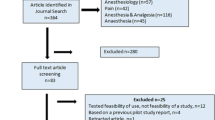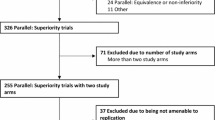Abstract
Purpose
The research productivity was estimated by publications from anesthesiology departments at Canadian universities over a five-year period, and the articles published were classified into several study designs.
Methods
In this observational study, the MEDLINE database was searched for publications listed by anesthesiology departments at Canadian universities as the primary corresponding source from 2000-2004. Abstracts were reviewed and each publication categorized into its respective methodological design. Impact factors of the journals in which the articles appeared were taken into consideration. “Total impact score” was defined as the total number of articles from a particular journal in a particular year multiplied by the impact factor value. Changes in overall publication numbers over the five-year period were compared and analyzed using Pearson correlation coefficients.
Results
Total Canadian anesthesia publications remained constant from 2000-2004. In this five-year time frame, the University of Toronto had the highest number of publications (271) followed by the University of Montreal (86), and McGill University (84). These universities conducted primarily randomized controlled trials (RCTs) whereas smaller Canadian universities mainly published case reports, reviews, and cohort studies. The number of RCTs conducted seems to be decreasing whereas the number of case reports and reviews being published are remaining constant over the five-year period.
Conclusion
Although overall numbers in anesthesia publications do not suggest a significant decline, the number of RCTs decreased during the years 2000-2004. The quality of anesthesia research appears to be comparable to those in other medical specialties, with larger institutions conducting RCTs and smaller institutions publishing more case reports.
Résumé
Objectif
La productivité en recherche a été estimée par les articles provenant des départements ďanesthésiologie des universités canadiennes sur une période de cinq ans. Les articles ont été classifiés selon la méthodologie de ľétude.
Méthode
Pour cette étude observationnelle, nous avons recherché dans MEDLINE les articles publiés par les départements ďanesthésiologie des universités canadiennes en tant que source primaire conforme entre 2000 et 2004. Les résumés ont été examinés et chaque article catégorisé selon sa méthodologie respective. Les facteurs ďimpact des revues dans lesquelles les articles paraissaient ont été considérés. «Le score ďimpact total» a été défini comme le total des articles ďune revue publiés au cours ďune année et multiplié par la valeur du facteur ďimpact. Les variations du nombre total ďarticles publiés sur cinq ans ont été comparées et analysées à ľaide des coefficients de corrélation de Pearson.
Résultats
Le nombre total ďarticles publiés sur ľanesthésie au Canada est demeuré constant entre 2000 et 2004. Pendant cette période, ľUniversité de Toronto a publié le plus ďarticles (271) suivie de ľUniversité de Montréal (86) et de ľuniversité McGill (84). Ces institutions ont surtout réalisé des études randomisées et contrôlées (ERC) tandis que les universités canadiennes plus.
Similar content being viewed by others
References
Nishino T. Research in anesthesia and the future of our specialty (Editorial). J Anesth 2002; 16: 185–6.
Orser BA, Miller DR. New opportunities for anesthesia research in Canada (Editorial). Can J Anesth 2002; 49: 895–9.
Figueredo E, Sanchez Perales G, Munoz Blanco F. International publishing in anaesthesia — how do different countries contribute? Acta Anaesthesiol Scand 2003; 47: 378–82.
Szokol JW, Murphy GS, Avram MJ, Nitsun M, Wynnychenko TM, Vender JS. Declining proportion of publications by American authors in major anesthesiology journals. Anesth Analg 2003; 96: 513–7.
Kumararatne M. A piece of my mind. Why publish? JAMA 1997; 277: 957.
Stossel TP, Stossel SC. Declining American representation in leading clinical-research journals. N Engl J Med 1990; 322: 739–42.
Science Citation Index (SCI) Journal Citation Reports. A bibliometric analysis of science journals in the ISI database. Philadelphia: Institute for Scientific Information; 1998–2003.
Myles PS, Gin T. Regression and correlation.In: Myles PS, Gin T. (Eds). Statistical Methods for Anaesthesia and Intensive Care. Oxford: Reed Educational and Professional Publishing Ltd.; 2000: 80.
Rosner B. Regression and correlation methods.In: Crockett C (Ed.). Fundamentals of Biostatistics, 5th ed. Pacific Grove, CA: Duxbury; 2000: 451–3.
Silcox LC, Ashbury TL, Milne B, VanDenKerkhof EG. Do anesthesiology residents want to be involved in research? Can J Anesth 2004; 51: A13 (abstract).
Pandit JJ, Yentis SM. All that glisters… how to assess the ‘value’ of a scientific paper. Anaesthesia 2005; 60: 373–83.
Horlocker TT, Brown DR. Evidence-based medicine: haute couture or the emperor’s new clothes? (Editorial). Anesth Analg 2005; 100: 1807–10.
Strippoli GF, Craig JC, Schena FP. The number, quality, and coverage of randomized controlled trials in nephrology. J Am Soc Nephrol 2004; 15: 411–9.
Brölmann HA, Kesteren PJ. Levels of evidence in endoscopic research: a longitudinal survey. Gynecol Surg 2004; 1: 91–3.
Greenfield ML, Rosenberg AL, O’Reilly M, Shanks AM, Sliwinski MJ, Nauss MD. The quality of randomized controlled trials in major anesthesiology journals. Anesth Analg 2005; 100: 1759–64.
Henderson SO, Brestky P. Predictors of academic productivity in emergency medicine. Acad Emerg Med 2003; 10: 1009–11.
Brambrink AM, Ehrler D, Dick WF. Publications on paediatric anaesthesia: a quantitative analysis of publication activity and international recognition. Br J Anaesth 2000; 85: 556–62.
Royal College of Physicians and Surgeons of Canada Clinician Investigator Program. Clin Invest Med 1997; 20: 261.
Lindberg DA. National Library Of Medicine provides access for all. U.S. Medicine [serial online]; [cited 2005 Jun 27] 2003: 46. URL available from; http:// www.usmedicine.com/column.cfm?columnID=120&iss ueID=46.
Greene NM. Anesthesiology journals, 1992. Anesth Analg 1992; 74: 116–20.
Opthof T. Sense and nonsense about the impact factor. Cardiovasc Res 1997; 33: 1–7.
Hansson S. Impact factor as a misleading tool in evaluation of medical journals (Letter). Lancet 1995; 346: 906.
Rydholm A. Impact factors (Editorial). Acta Orthop Scand 1998; 69: 221.
Seglen PO. Citation frequency and journal impact: valid indicators of scientific quality? (Editorial). J Intern Med 1991; 229: 109–11.
Seglen PO. Why the impact factor of journals should not be used for evaluating research. BMJ 1997; 314: 498–502.
Campbell FM. National bias: a comparison of citation practices by health professionals. Bull Med Libr Assoc 1990; 78: 376–82.
Gallagher EJ, Barnaby DP. Evidence of methodologic bias in the derivation of the Science Citation Index impact factor. Ann Emerg Med 1998; 31: 83–6.
Gisvold SE. Citation analysis and journal impact factorsis the tail wagging the dog? Acta Anaesthesiol Scand 1999; 43:971–3.
Zetterstrom R. Impact factor and the future of Acta Paediatrica and other European medical journals. Acta Paediatr 1999; 88: 793–6.
Gagnon RE, Macnab AJ, Blackstock D. An inventory of Canadian anesthesiology. Human research from 1995 through 1999. Can J Anesth 2001; 48: 452–8.
Rahman M, Sakamoto J, Fukui T. Research output in anaesthesia: a quantitative ranking (Letter). Anaesthesia 2002; 57: 1213–4.
Alderson P,Green S,Higgins J. [Glossary of Terms in the Cochrane Collaboration.] Cochrane Handbook for Systematic Reviews of Interventions 4.2.4 [updated March 2003]. Available from URL; http://www. cochrane.org/resources/glossary.htm [accessed 2005 Jun 27].
Author information
Authors and Affiliations
Corresponding author
Rights and permissions
About this article
Cite this article
Tsui, B.C., Li, L.X., Ma, V. et al. Declining randomized clinical trials from Canadian anesthesia departments?. Can J Anesth 53, 226–235 (2006). https://doi.org/10.1007/BF03022207
Accepted:
Published:
Issue Date:
DOI: https://doi.org/10.1007/BF03022207




